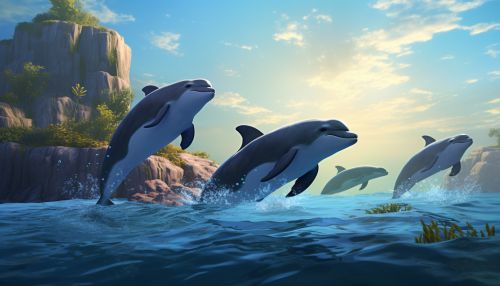The Evolution of Social Learning in Marine Mammals
Introduction
Social learning, the process by which individuals learn from others, has been observed in a variety of species, including marine mammals. This article will delve into the evolution of social learning in marine mammals, focusing on the ways in which these creatures have adapted to their environment and how their social structures have shaped their learning processes.


Social Learning in Marine Mammals
Social learning is a crucial aspect of survival for many marine mammals. It allows these animals to adapt to changing environments, find food, avoid predators, and communicate with each other. The evolution of social learning in marine mammals is a fascinating topic, as it provides insight into the complex social structures and behaviors of these creatures.
Dolphins
Dolphins are known for their high intelligence and complex social structures, which have likely played a significant role in the evolution of their social learning abilities. Dolphins have been observed using tools, a behavior that is thought to be learned socially. For example, some dolphins use sponges to protect their noses while foraging on the seafloor, a behavior known as sponging. This behavior is primarily observed in female dolphins and is thought to be passed down from mother to calf.
Whales
Whales, like dolphins, have complex social structures and are known for their impressive social learning abilities. For example, killer whales (or orcas) have been observed learning hunting techniques from other members of their pod. This includes the unique behavior of beaching themselves to catch seals on ice floes, a risky but effective hunting strategy known as wave-washing.
Seals and Sea Lions
Seals and sea lions, members of the pinniped family, also exhibit social learning behaviors. For example, young seals have been observed copying the foraging behaviors of their mothers, indicating that these behaviors are learned rather than innate. Similarly, sea lions have been observed learning complex tasks from other sea lions, demonstrating the presence of social learning within their species.
Evolutionary Aspects of Social Learning
The evolution of social learning in marine mammals is thought to be closely tied to the complexity of their social structures. In species with complex social structures, such as dolphins and whales, social learning is likely a crucial aspect of survival.
Adaptive Significance
Social learning allows marine mammals to adapt to changing environments and learn new behaviors that can aid in their survival. For example, the ability to learn new hunting techniques from other members of their group allows these animals to effectively find food in a variety of situations.
Social Structure and Learning
The social structure of marine mammal groups likely plays a significant role in the evolution of social learning. In species with complex social structures, individuals have more opportunities to observe and learn from others. This can lead to the development of complex behaviors, such as tool use in dolphins or unique hunting strategies in whales.
Conclusion
The evolution of social learning in marine mammals is a complex process that is closely tied to the social structures and adaptive needs of these animals. By studying this process, researchers can gain valuable insight into the behaviors and survival strategies of marine mammals, as well as the evolutionary pressures that have shaped these strategies.
